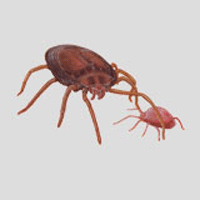Keeping Clover Mites Outside
By Chris Williams on May 9, 2013.

Question
Last fall we had our entire lawn redone. They took it down to bare dirt and then reseeded. It looks fantastic right now, lush and green, but it seems to be full of tiny red mites or ticks. My daughter was covered with them when she laid on the grass. I’m also finding them in the house. Do you know what they are? Do they bite?
Answer
I think you might be talking about clover mites. They are a common problem in new lawns or even in established lawns that have been over-fertilized.
You can see clover mites, although they are smaller than a pinhead. They can be reddish in color which leads people to think that they are blood suckers. Not so. They feed and live in grass, clover, ivy, on shrubs, or on other plants. Their feeding usually does no real damage to lawns.
Clover mites are active in the cooler weather of spring and fall, when temperatures are below 80° F. They may move indoors when grass dies or is removed, or when very cold, wet, or hot weather forces them to seek a more desirable place. Homes where grass or weeds are allowed to grow right up next to the house have the biggest problem with clover mites moving inside. The mites are most abundant in dry, sunny areas.
Clover mites can enter a home through any tiny crack or crevice and they are so tiny that screens won’t keep them out. When clover mites get inside, they can sometimes be seen in large numbers on table tops, floors, windowpanes, and other surfaces. They don’t survive long indoors and they don’t bite, or carry disease, or damage anything indoors as long as they are not crushed. When crushed, they can leave a reddish stain, most noticeable on light surfaces. Vacuuming them up with a soft brush attachment is usually the best indoor control measure. A pest control company can help if you have a heavy indoor invasion.
How to Reduce Clover Mite Problems
Probably the best, and certainly most permanent, cure for clover mites is to remove grass next to the house. Instead, install an 18-inch wide strip of bare dirt, pea gravel or ornamental mulch around the foundation, or plant the strip with clover mite-resistant flowers. Also, prune back shrubs or ivy that are touching the house, and limit fertilizer application on your lawn to the fall. Once new lawns are established, clover mite problems gradually subside.
When clover mites are migrating from the lawn, they usually crawl up the outside walls of your house to get inside. They can gather by the thousands under siding or shingles, or along window frames, especially on the warm, sunny side of the house. Our technicians can apply a perimeter treatment around the outside foundation of your home that will intercept clover mites before they can climb exterior walls. Give us a call.